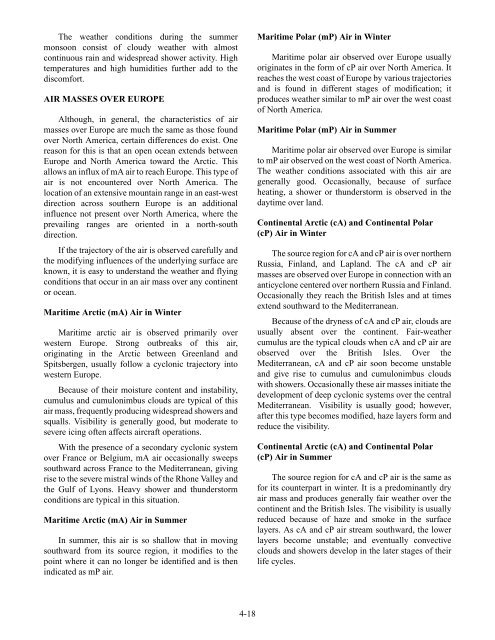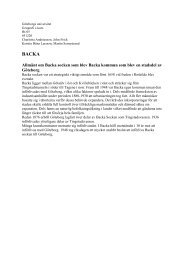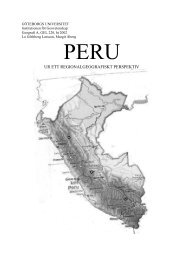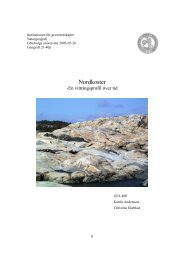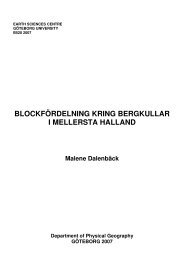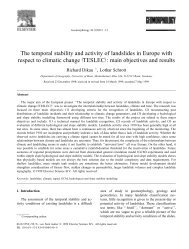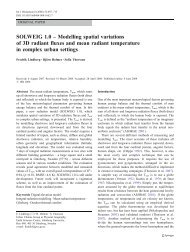AIR MASSES AND FRONTS
AIR MASSES AND FRONTS
AIR MASSES AND FRONTS
You also want an ePaper? Increase the reach of your titles
YUMPU automatically turns print PDFs into web optimized ePapers that Google loves.
The weather conditions during the summer<br />
monsoon consist of cloudy weather with almost<br />
continuous rain and widespread shower activity. High<br />
temperatures and high humidities further add to the<br />
discomfort.<br />
<strong>AIR</strong> <strong>MASSES</strong> OVER EUROPE<br />
Although, in general, the characteristics of air<br />
masses over Europe are much the same as those found<br />
over North America, certain differences do exist. One<br />
reason for this is that an open ocean extends between<br />
Europe and North America toward the Arctic. This<br />
allows an influx of mA air to reach Europe. This type of<br />
air is not encountered over North America. The<br />
location of an extensive mountain range in an east-west<br />
direction across southern Europe is an additional<br />
influence not present over North America, where the<br />
prevailing ranges are oriented in a north-south<br />
direction.<br />
If the trajectory of the air is observed carefully and<br />
the modifying influences of the underlying surface are<br />
known, it is easy to understand the weather and flying<br />
conditions that occur in an air mass over any continent<br />
or ocean.<br />
Maritime Arctic (mA) Air in Winter<br />
Maritime arctic air is observed primarily over<br />
western Europe. Strong outbreaks of this air,<br />
originating in the Arctic between Greenland and<br />
Spitsbergen, usually follow a cyclonic trajectory into<br />
western Europe.<br />
Because of their moisture content and instability,<br />
cumulus and cumulonimbus clouds are typical of this<br />
air mass, frequently producing widespread showers and<br />
squalls. Visibility is generally good, but moderate to<br />
severe icing often affects aircraft operations.<br />
With the presence of a secondary cyclonic system<br />
over France or Belgium, mA air occasionally sweeps<br />
southward across France to the Mediterranean, giving<br />
rise to the severe mistral winds of the Rhone Valley and<br />
the Gulf of Lyons. Heavy shower and thunderstorm<br />
conditions are typical in this situation.<br />
Maritime Arctic (mA) Air in Summer<br />
In summer, this air is so shallow that in moving<br />
southward from its source region, it modifies to the<br />
point where it can no longer be identified and is then<br />
indicated as mP air.<br />
4-18<br />
Maritime Polar (mP) Air in Winter<br />
Maritime polar air observed over Europe usually<br />
originates in the form of cP air over North America. It<br />
reaches the west coast of Europe by various trajectories<br />
and is found in different stages of modification; it<br />
produces weather similar to mP air over the west coast<br />
of North America.<br />
Maritime Polar (mP) Air in Summer<br />
Maritime polar air observed over Europe is similar<br />
to mP air observed on the west coast of North America.<br />
The weather conditions associated with this air are<br />
generally good. Occasionally, because of surface<br />
heating, a shower or thunderstorm is observed in the<br />
daytime over land.<br />
Continental Arctic (cA) and Continental Polar<br />
(cP) Air in Winter<br />
The source region for cA and cP air is over northern<br />
Russia, Finland, and Lapland. The cA and cP air<br />
masses are observed over Europe in connection with an<br />
anticyclone centered over northern Russia and Finland.<br />
Occasionally they reach the British Isles and at times<br />
extend southward to the Mediterranean.<br />
Because of the dryness of cA and cP air, clouds are<br />
usually absent over the continent. Fair-weather<br />
cumulus are the typical clouds when cA and cP air are<br />
observed over the British Isles. Over the<br />
Mediterranean, cA and cP air soon become unstable<br />
and give rise to cumulus and cumulonimbus clouds<br />
with showers. Occasionally these air masses initiate the<br />
development of deep cyclonic systems over the central<br />
Mediterranean. Visibility is usually good; however,<br />
after this type becomes modified, haze layers form and<br />
reduce the visibility.<br />
Continental Arctic (cA) and Continental Polar<br />
(cP) Air in Summer<br />
The source region for cA and cP air is the same as<br />
for its counterpart in winter. It is a predominantly dry<br />
air mass and produces generally fair weather over the<br />
continent and the British Isles. The visibility is usually<br />
reduced because of haze and smoke in the surface<br />
layers. As cA and cP air stream southward, the lower<br />
layers become unstable; and eventually convective<br />
clouds and showers develop in the later stages of their<br />
life cycles.


